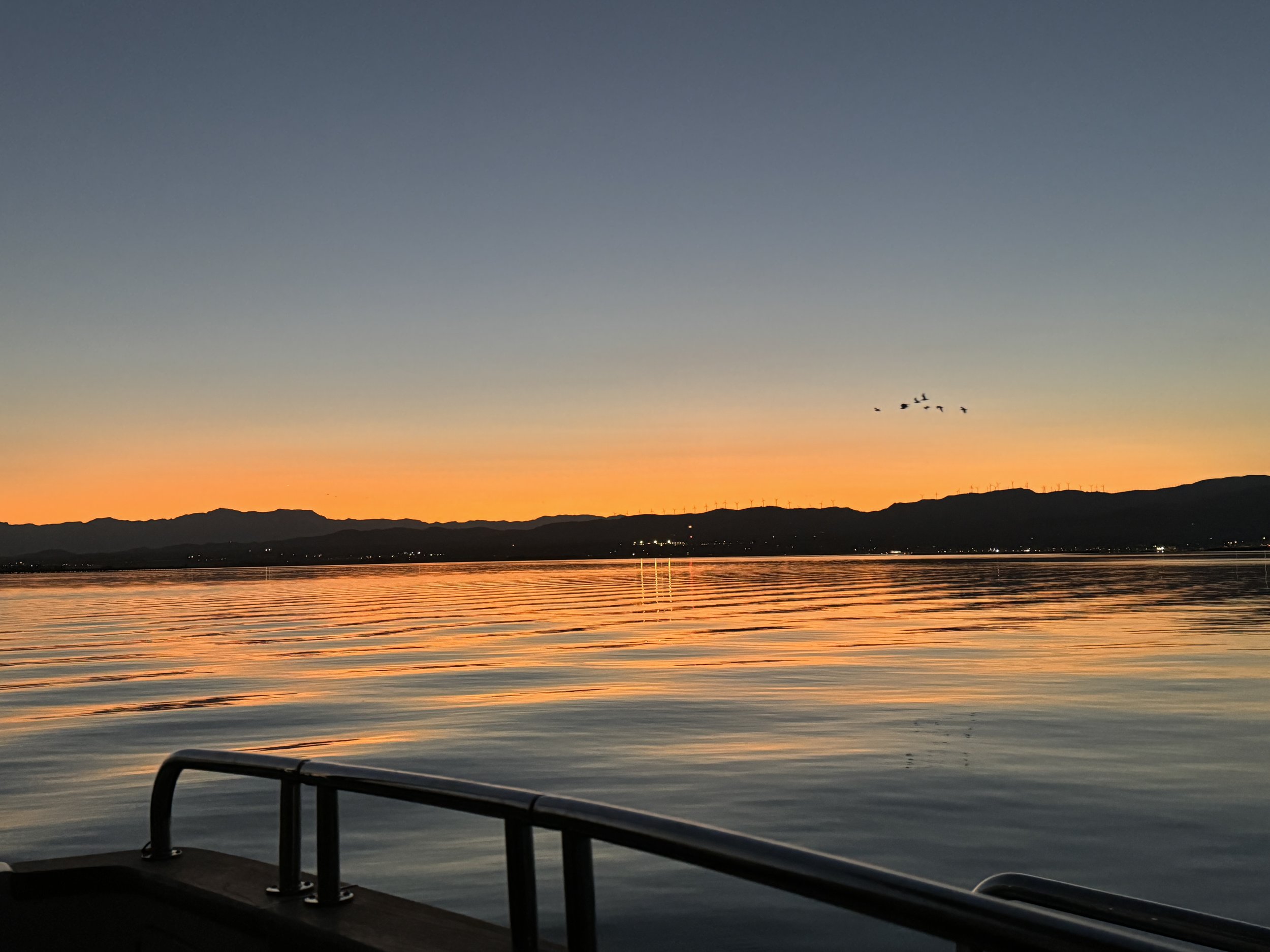Adventuring Once Again
We stayed in Port Ginesta longer than expected waiting for our isolator and the electrician. We started out in a berth next to the marina office which was under construction and moved to a quieter berth two days later. There were other live-aboards on this pier which made it feel like more of a neighborhood. We shared a glass of wine with the Spanish/Venezuelan couple across from us and later met a young French couple who had just bought their first boat that day. They moved aboard a day later and got to work cleaning and sorting through all the gear. Neither had ever sailed before but they thought they would enjoy the lifestyle so they began sailing lessons and are now well on their way. We shared a meal they brought over to Meraki served with lots of laughter.



We worked on boat chores and Tom began installation of our new Garmin OnDeck which is a vessel monitoring tool that will allow us to remotely monitor Meraki’s information (battery voltage, activity of bilge pumps, shore power, temperature sensors, etc). It should bring us peace of mind when we are not aboard knowing that we will be alerted to any issues.




When we weren’t hiding out from the heat doing chores we explored the village and the beaches, took long walks and re-provisioned.




Finally our isolator was installed and we slipped the lines mid-morning and began our leapfrog south down the Costa Dorada (Golden Coast) so called because of its golden sandy beaches. We anchored one night at the mouth of the Río Ebro, in a huge flat muddy river delta surrounded by shallows and shoals. We approached super slowly, eyes glued to the depth sounder, and found ourselves in a quiet little bay filled with mussel farms and surrounded by rice fields and salinas (saltpans). The bird life was extraordinary!












We continued south down the Costa del Azahar (Orange Blossom Coast) which is primarily low and flat with the exception of Oropesa where there are a few mountains along the coast. We continued leapfrogging our way to Valencia where we planned to spend a few days exploring.




Valencia is an incredible place. We took an Uber into the old city and started at the Mercado Central. This is the most famous market in Valencia. The Central Market is a beautiful building with impressive iron columns and a remarkable ceiling. We bought fruit and smoothies and took in all the colorful displays and amazing aromas.













From there we checked out Lonja de la Seda (the Silk Exchange). At the time of construction, the most important guild in Valencia was that of the silk merchants. In its heyday it was one of the biggest silk trade centers in the world. Built between 1482 and 1533 the building is considered a great example of the late Valencian Gothic-style architecture. Typical of gothic architecture there are over two dozen gargoyles along the top edge of the building. Their function is to direct rainwater off the roof though why they depict dragons or lions, or lizards, I’ve no idea.
We walked on to the Palacio del Marquez de Dos Aguas, a beautiful palace which now houses the Ceramics Museum. Sadly, it was closed that day, but the palace itself was worth seeing with it’s 18th century Baroque facade.













Hot, sweaty and hungry we walked to the Mercado de Colón which, though once a produce market, is a newly restored open air market featuring several bars, cafés, and restaurants with al fresco terraces. We found a table under a giant whirring fan and enjoyed a delicious lunch and cold drinks.



Somewhat rejuvenated we decided to walk, rather than bus, across town to the City of Arts and Sciences. Unknowingly, we happened upon Spain’s largest urban park which runs through Valencia like a river. In fact, it was once a river. Valencia was built around the Turia River but was continually plagued by floods. In 1957 a plan was concocted to reroute the river outside of the city leaving behind a dry riverbed. The aim then became to recreate the natural beauty of the former riverbed. The result is 250 acres of green grass and rose bushes; palm, orange, and pine trees; fountains; ponds; and a variety of recreational facilities threading through the heart of the city.
Our leisurely stroll through the shady Turia Park delivered us directly to the City of Art and Sciences. Holy Crap - mind blown! This futuristic looking complex holds the most unusual buildings I’ve ever seen. The main building, the Palacio de las Artes Reina Sofía (Queen Sofia Palace of the Arts) looks a bit like a cross between a sea creature and a spaceship and is surrounded by more than 71,000 square meters (about 17.5 acres) of beautiful landscaping and water features. It holds several large stages equipped with the latest technology and is used for all sorts of opera, plays, musical and dance performances.
We walked through the Hemisfèric building which houses a planetarium, 3D screen, and IMAX Cinema and on through the Museo de las Ciencias Príncipe Felipe (Prince Philip Science Museum). This is an interactive museum dedicated to science, technology and the environment.
Finally we arrived at the the Oceanogràfic’s buildings which seemed to float on the waters surrounding it. Its main objective is to promote the conservation of the seas and their inhabitants through research and education projects related to the worlds oceans. It is quite spectacular and home to around 45,000 animals from 500 different species.












We ended our tour of Valencia there, both tired and content. We made our way home to the marina and after a simple dinner aboard Meraki we sat and watched August’s Supermoon Blue Moon rise above the marina. The perfect ending to a fantastic day.
Note: Photo captions will not appear if viewing on a cell phone.








